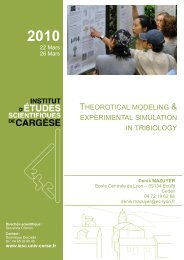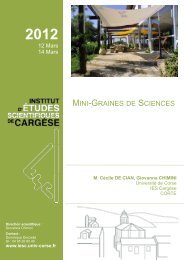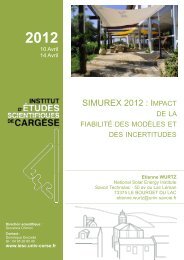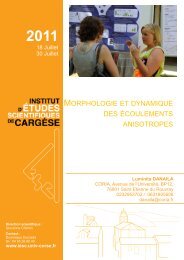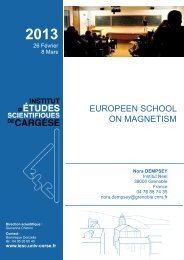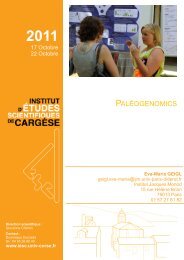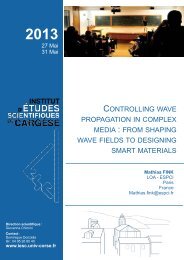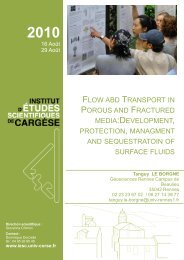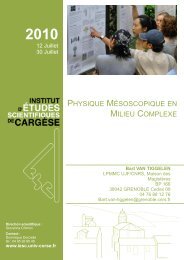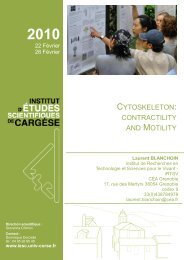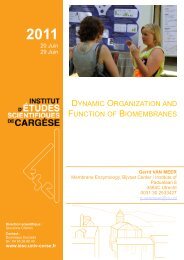nanoelectronics - Institut d'Études Scientifiques de Cargèse (IESC)
nanoelectronics - Institut d'Études Scientifiques de Cargèse (IESC)
nanoelectronics - Institut d'Études Scientifiques de Cargèse (IESC)
You also want an ePaper? Increase the reach of your titles
YUMPU automatically turns print PDFs into web optimized ePapers that Google loves.
Tuesday<br />
the energy level spacings at the spectrum edges of large Gaussian matrices. In particular the<br />
<strong>de</strong>lay-time and the thermopower have the same universal edge distributions for arbitrary M<br />
as those for an M=2 scatterer, which we obtain analytically.<br />
[1] A. Abbout, G. Fleury, J.-L. Pichard and K. Muttalib, in preparation<br />
[2] P. W. Brouwer, K. M. Frahm and C. W. J. Beenakker, Quantum Mechanical Time-Delay<br />
Matrix in Chaotic Scattering, Phys. Rev. Lett. 78, 4737 (1997)<br />
__________________________________________________________________________<br />
Harvesting fluctuations at electrical hot spots<br />
Rafael Sánchez<br />
<strong>Institut</strong>o <strong>de</strong> Ciencia <strong>de</strong> Materiales <strong>de</strong> Madrid (ICMM-CSIC), Madrid, Spain<br />
In electrical circuits hot spots occur naturally at places where energy is dissipated. Here we<br />
propose a controlled experiment which can <strong>de</strong>monstrate the appearance of directed current<br />
as a consequence of a hot spot. We investigate transport generated in Coulomb coupled<br />
electrical conductors from excess electric or thermal fluctuations at the coupling capacitance.<br />
If one of the conductors supports a bias voltage, out of equilibrium charge fluctuations<br />
remove <strong>de</strong>tailed balance in the unbiased system manifested in a drag current. Non linear<br />
fluctuation relations can nevertheless be obtained [1].<br />
Coulomb coupled conductors permit separate directions of the heat and current flux [2]. In<br />
our mo<strong>de</strong>l, one of the conductors is connected via only one lead to a hot reservoir. The other<br />
conductor is connected to two leads. Such a geometry can be used for <strong>de</strong>tection of non<br />
linear heat fluctuations [3]. We investigate the minimal conditions nee<strong>de</strong>d to generate<br />
directed current flow for a system of two quantum dot conductors in which both energy and<br />
charge states are quantized. In quantum dots energy to current conversion can be optimal<br />
with one electron transferred for every heat quantum given up by the hot reservoir. We show<br />
that at the point of maximum power extraction the efficiency approaches one half of the<br />
Carnot efficiency. However, the generated power is small.<br />
Larger currents can be generated in a chaotic mesoscopic cavity coupled to two leads. Non<br />
linearities due to energy <strong>de</strong>pen<strong>de</strong>nt contact transmission to leads are responsible for the<br />
rectification of thermal fluctuations in a coupled hot cavity, leading to an electrical current [4].<br />
The maximum power produced by the system will be discussed.<br />
[1] R. Sánchez, R. López, D. Sánchez, and M. Büttiker, Mesoscopic Coulomb drag, broken<br />
<strong>de</strong>tailed balance and fluctuation relations, Phys. Rev. Lett. 104 076801 (2010)<br />
[2] R. Sánchez, and M. Büttiker, Optimal energy quanta to current conversion, Phys. Rev. B<br />
83 085428 (2011)<br />
[3] R. Sánchez, and M. Büttiker, Detection of single electron heat transfer statistics,<br />
arXiv:1207:2587<br />
[4] B. Sothmann, R. Sánchez, A.N. Jordan, and M. Büttiker, Rectification of termal<br />
fluctuations in a chaotic cavity heat engine, Phys. Rev. B 85 205301 (2012)



